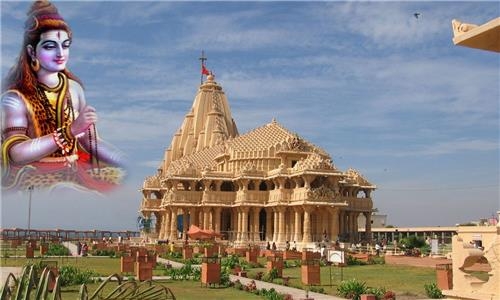Somnath located near Veraval , Gujarat is considered first and foremost of all Jyotirling. It is named after the Moon (Soma) who worshipped Shiva to get rid of a curse put on him by his father-in-law, Daksha. On getting Shiva’s blessings, the moon regained his light and this is why this town is also referred to as Prabhas. The original Somanth temple was built by the moon in pure gold and later rejuvenated by Ravana in silver, by Krishna in sandalwood and finally by Bhimadeva in stone. So, let us learn more about this wondrous temple.
It would be apt to describe Somnath temple in Gujarat as “indestructible”. A scribble through the Somnath temple history would tell you that the temple has been destroyed 17 times and each time it has been resurrected! The first temple was built by a Chaulukya king some time before 997 AD. Most of us are under the conception that Mahmud of Ghazni (in 1025–1026) was the first person to destroy and loot this revered Indian temple. But you are up for a surprise in this regard! Some historians believe that Mahmud of Ghazni was responsible for the third major destruction to the temple (and not the first one, as believed by most of us)! The first temple was destroyed by some unknown Arab invader!
However, each time the Somnath Mandir has been destroyed, a new temple has come up with more beauty and splendour. The last resurrection of the Somnath temple took place under the command of “Iron Man of India”, Sardar Vallabhai Patel (between 1947 and 1951).
Old Somnath Temple
Opposite the New Somnath Temple, is a pink, painted structure that has played witness to the colourful history of this land. In the seventeenth century this temple came under the rule of the Marathas. It is said that Ahilyabai Holkar was deeply moved by the ravaged state of the temple and took on herself the task of reconstructing it. It is also said that the location of the swayambhulinga came in Ahilyabai’s dreams post which she started the construction immediately. Many Hindus believe that this temple contains the original jyotirling which was buried assuming that the original temple would be raided. Unlike the new Somnath Temple, everybody is allowed to enter the garbagriha and perform pooja with the help of the local priest. The aarti offered here is accompanied by multiple musical instruments including damroos and makes for a tantalising experience.
Bhalka Tirth
As per Puranic accounts, shortly after the death of his elder brother (Balarama), Lord Krishna retired into the forest to meditate. While sitting under a tree, a hunter named Jara mistook his partly visible foot as a deer. He shot an arrow which mortally wounded Lord Krishna. Bhalka Tirtha is situated on the exact place where Lord Krishna was struck by an arrow and left the mortal world. The tree under which he was sitting, passes through the roof of this temple.
Triveni Sangam
As per Puranic accounts, shortly after the death of his elder brother (Balarama), Lord Krishna retired into the forest to meditate. While sitting under a tree, a hunter named Jara mistook his partly visible foot as a deer. He shot an arrow which mortally wounded Lord Krishna. Bhalka Tirtha is situated on the exact place where Lord Krishna was struck by an arrow and left the mortal world. The tree under which he was sitting, passes through the roof of this temple.
Pandav Gufa
Have you ever read the Mahabharata? The Panch Pandavs- namely Yudhistr, Bheema, Arjuna, Nakul and Sahadev along with their mother have spent their time in their exile term. This is basically a cave temple and is located in the Lalghati which is near the Somnath town and visiting it is one of the popular things to do in Somnath. The Late Baba Narayandas discovered this temple in 1949. Apart from that, this Gufa has shrines that are dedicated to Lord Hanuman, Lord Shiva, Lord Ram, Lord Lakshman, Sita Devi, and Goddess Durga.
Temple Timings
Timing For Darshan at Somnath : 07:00 Am To 09:00 Pm
Timing For Aarti : 07:00 Am, 12:00 Noon & 07:00 Pm
Timing For Sound & Light Show : 08:00 Pm To 09:00 Pm


